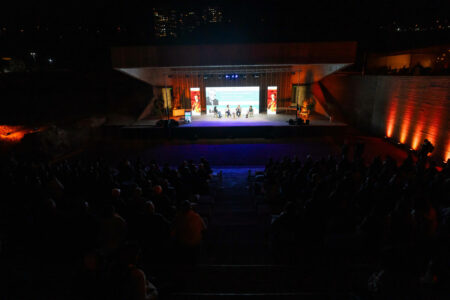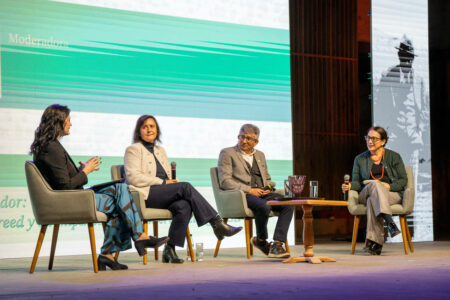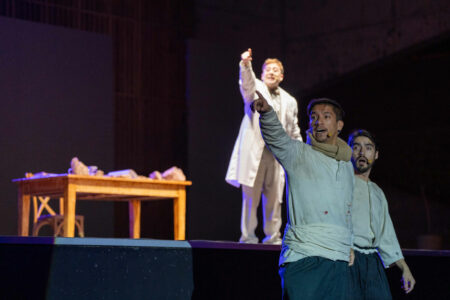
Mining Month: SQM Iodine Plant Nutrition presented literary work highlighting scientist Stanley Freed
14/Aug/2024
In the amphitheater at the Huanchaca Ruins, 250 people participated in the launching of a book highlighting the contribution and legacy of Dr. Freed, an American scientist recognized for creating solar evaporation ponds to economically extract, simply through the sun's energy, a wealth of riches contained in caliche ore; an innovation that emerged in the early 1940s and is still in use in mining today.
As part of Mining Month, the chemical company presented the book “The Man who Knew the Most about Caliche Ore in the World,” a biography about Edgar Stanley Freed, a great talent who stood out for his extensive research into solar evaporation ponds, which are still a fundamental part of the production processes at the world’s leading producer of iodine and specialty fertilizers.
“As heirs of the saltpeter industry where Staley Freed played a leading role, we value his contribution and legacy, working selflessly to grow a fading industry with ingenuity and perseverance. Evaporation ponds, a very advanced technological development for the 1940s, are still used today and are a key element in our production processes, so we are highlighting and recognizing a man of great importance to non-metallic mining today. This book allows us to revive his memory with respect and admiration,” said Pablo Altimiras, CEO of SQM Iodine Plant Nutrition.
It was produced in collaboration with the publishing house Memoria Creativa, founded by a group of SQM workers who researched this American scientist’s life in the saltpeter pampa from his arrival until his death, highlighting his contribution and legacy in the mining industry.
Beatriz Oelckers, Vice President of Research and Innovation for SQM Iodine Plant Nutrition and the book’s author commented, “This whole process was very exciting because we connected in a slightly different way with one of the main researchers and developers of the processes still in place at our company today. We connected through his personal history, his professional history, his family and his emotions, thus recognizing a character that was and is very important in the global mining history.”
The book launch was set in the splendor of the pampa and attended by regional and municipal authorities, together with Dr. Freed’s family and various local groups and organizations, who enjoyed performances by the Antofagasta company TeatroRocco and renowned national actress Luz Valdivieso.
In the framework of the activity, Regional Governor Ricardo Díaz remarked, “What SQM is doing is very relevant, rescuing the history of those who were able to innovate, to generate creativity, and who in some way are marking the history of our north. We have to be able to revive our heritage, to rescue the history that has marked the northern industry and spotlight it so that Chile knows that science, research and innovation are taking place here and that this innovation has done the country a lot of good.”
Sebastian Freed, great-grandson of Dr. Stanley Freed, who had the original idea for the book, explained, “This tribute has been really beautiful. At the age of 14, I began to get interested in my family legacy and to know a little more about my great-grandfather. There I found many documents that my grandmother had kept, motivating me to spread his story, and that was the impetus for approaching SQM, to achieve this important milestone.”
In addition, the book’s author and SQM executive, Beatriz Oelckers, and the Senior Research Director of SQM Iodine Plant Nutrition, Alejandro Lara, together with Carolina Díaz, founder of Memoria Creativa, participated in the panel discussion: “Innovative Legacy: Dr. Stanley Freed and his Impact on Mining in the 21st Century,” where they shared how Freed’s work and international relevance came to be.”
One attendee, Demetrio Delgado, highly valued this cultural gathering: “I was very impressed to learn the story of this scientist, especially because I am a native of María Elena, so I completely identify with his love for the pampas. I am grateful to be part of this tremendous cultural achievement.”
Biography of Stanley Freed
His impetus established him internationally as the chief scientific consultant to the Guggenheim Brothers. Many told him his inventions would not be possible. However, in the last decade of his life he would devote himself to realizing his ultimate scientific ambition: creating solar evaporation ponds to economically extract saltpeter, borax, potassium, magnesium and an unimaginable wealth of riches contained in caliche ore, simply through the sun’s energy.
His life was marked by his love for the pampas. He came to the Atacama Desert for three years and stayed for the rest of his life. He saw the towns of María Elena and Pedro de Valdivia grow from their foundations and met his wife in the pampas, with whom he had two children. With his advanced scientific inventions, he helped the Chilean nitrate industry survive the devastating crisis spurred by the Great Depression of 1929.
In addition to creating production plants and solar evaporation ponds, he invented ‘Freed cement’ to waterproof the base of the ponds to cope with climate and seismic movements. Undoubtedly, a scientist ahead of his time, this María Elena transplant revolutionized science and the saltpeter industry.
His remains are currently resting in the Antofagasta cemetery.



